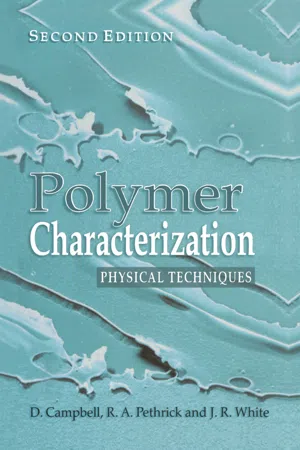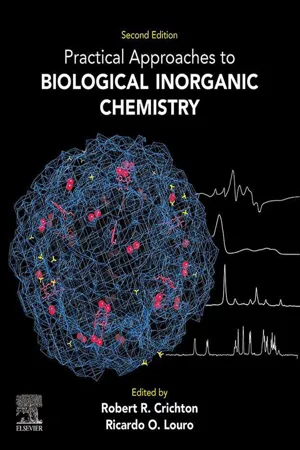Chemistry
FT NMR
FT NMR, or Fourier Transform Nuclear Magnetic Resonance, is a powerful analytical technique used to study the structure and dynamics of molecules. It involves applying a strong magnetic field to a sample, which causes the nuclei of certain atoms to resonate at characteristic frequencies. By analyzing the resulting signals, valuable information about the chemical environment and interactions within the sample can be obtained.
Written by Perlego with AI-assistance
8 Key excerpts on "FT NMR"
Learn about this page
Index pages curate the most relevant extracts from our library of academic textbooks. They’ve been created using an in-house natural language model (NLM), each adding context and meaning to key research topics.
- eBook - ePub
- Raghbir Singh Khandpur(Author)
- 2019(Publication Date)
- Wiley(Publisher)
FT‐NMR spectrometers have an integration algorithm included in the spectrometer software, and the resonance peak areas may be presented graphically as stepped lines or tabulated as numeric values. Sensitivity enhancement is the major attraction of the Fourier transform technique, which has great importance in biochemical field.Figure 341.3 shows a typical FT‐NMR installation Fourier 300 from M/s Bruker, which is an ideal system for chemical education and routine analysis. The software packages that come with this instrument can expand its use to include structure elucidation, structure consistency checks, analysis of mixtures, and absolute quantification experiments.Figure 341.3 Typical 300 MHz FT‐NMR spectrometer.Source: Photo reproduced with permission from M/s Bruker, UK.Specifications
FT‐NMR spectrometer
- Magnet: 400 MHz, superconducting magnet at 9 T
- Magnet drift: <4 Hz/h
- Cooling: Liquid helium, hold time of >300 days
- Shims: At least 20 room temperature shims
- Gradient coils: For gradient shimming
- Frequency resolution: <0.005 Hz or better
- NMR software: For 1D and 2D acquisition and processing
- Temperature: Variable below and above ambient (−140 to +150 °C)
Applications
NMR spectroscopy finds applications in the study of the structure of molecules, the interaction of various molecules, the kinetics or dynamics of molecules, and the composition of mixtures of biological materials. Biochemical information can also be obtained from living tissue with this technique. The magnetic resonance imaging (MRI - eBook - ePub
Understanding Bioanalytical Chemistry
Principles and Applications
- Victor A. Gault, Neville H. McClenaghan(Authors)
- 2013(Publication Date)
- Wiley(Publisher)
In the NMR spectrum, T 2 time determines the width of the NMR signal, where nuclei with large T 2 times give rise to sharp signals and those with shorter T 2 times have broader signals. Relaxation effects have structural and dynamic applications, where T 1 measurements are useful for dynamic (motional) studies, while the so-called nuclear Overhauser effect can give structural information (such as internuclear separations). Together these approaches can give lots of information about the molecules being studied. Principles of NMR spectroscopy NMR spectroscopy exploits the magnetic properties of nuclei to give important qualitative and quantitative information on biological samples. There are various different forms of this important technique, but in each case NMR spectroscopy relies on fundamental NMR theory discussed earlier. There are three essential requirements for NMR recordings: (i) an intense and static (stable) magnetic field with defined field strength; (ii) a source of RF radiation (high frequency transmitter) to irradiate and excite nuclei in the sample; and (iii) a method or device to detect the NMR signal (record resonance energy). A typical NMR spectrometer is outlined in Figure 11.3. The earliest form of NMR spectroscopy relied on CW methods, where experiments were conducted with the RF field present throughout, bringing nuclei with different chemical shifts into resonance by either keeping the electromagnetic frequency fixed and sweeping the magnetic field, or vice versa. However, the origin of pulse methods including FT-NMR soon superseded CW methods. Pulse methods depend on applying a short intense burst of RF radiation to a sample to set nuclear moments spinning around the line of the magnetic field in a motion called precession. As such, each nucleus precesses around the static field direction at a frequency called the Larmor frequency - eBook - ePub
Polymer Characterization
Physical Techniques, 2nd Edition
- Dan Campbell, Richard A. Pethrick, Jim R. White(Authors)
- 2017(Publication Date)
- CRC Press(Publisher)
6.2.5 .Early NMR spectrometers operated in a continuous wave mode. Experimentally this may be carried out by either fixing the frequency (v) and varying the applied field (B) until the resonance condition is satisfied, or by varying the frequency at constant field strength. In practice both methods have been employed. However, continuous wave spectrometers have been largely superceded by machines employing Fourier Transform techniques and these will be considered in the following sections.6.2.3 Fourier Transform Spectroscopy
Fourier transform spectroscopy relies on the response of the magnetic nuclei to a broad band frequency source which simultaneously excites the spin system with a range of frequencies. The resultant signal is transformed to give the NMR spectrum. The broad band of frequencies is achieved by applying to the sample a strong RF pulse having a frequency close to the Larmor frequency. Application of such a pulse for a duration r gives an effective range of frequencies of 1/τ . For example, for a pulse duration of 5 ps, the bandwidth is 200 kHz. This is equivalent to simultaneous illumination of the sample with a range of frequencies. Provided that the resonance frequencies of the nuclei in the sample lie within this frequency range, they will be excited to their upper energy state. In practice it is desirable to select τ −1 to be one or two orders of magnitude greater than the chemical shift range (Section 6.2.6 ) under investigation.Pulse techniques may be treated by considering the vector model of nuclear spin angular momentum (Fig 6.2 ). In the absence of a magnetic field the spins are oriented randomly with equal numbers of α and β spins. When a magnetic field is applied the spins precess about the field or z direction and there is a net magnetization (M ) in the direction of the field. This is because there is a slight excess of nuclear spins in the lower energy state given by the Boltzmann distribution. The application of a radiofrequency pulse, having a field strength B 1 at right angles to the main magnetic field (in the x–y plane) for a certain time τ (typically of the order of microseconds) causes the magnetization vector to rotate towards the x–y plane. The nutation angle θ , in radians, through which it rotates is given by θ = γ B 1 τ . When θ = 90° this is termed a 90° pulse and the magnetization vector is then rotating in the x–y plane with the Larmor frequency. (A 180° pulse is equivalent to inversion of the populations of the α and β energy levels.) It is sometimes more convenient to consider the phenomenon by using a rotating frame of reference. With the reference frame rotating with the Larmor frequency, the application of the radiofrequency (B 1 ) may be said to rotate the magnetization vector into the x–y - Gauri Misra(Author)
- 2019(Publication Date)
- Academic Press(Publisher)
The chapter offers a practical tool concerning the essential procedures related to principle, data collection, analysis, and interpretation of nuclear magnetic resonance (NMR) applied to biological sciences. The primary purpose is to introduce the reader with a brief history and the main applications of the technique, besides presenting an essential explanation of the physical principles required for understanding the subject. An informative theoretical base enables the user to acquire a critical approach to deep discussions and problem solving to biological objectives. The various examples delineate the different dimensions of the technique with the help of vivid illustrations that are routinely used for structural understanding of various macromolecules and biological phenomena. The chapter outlines the instructions for the beginners, describing the preparation of the NMR samples, and machine usage for accurate measurements. The sample NMR spectra, real NMR data, and stepwise descriptive interpretation are presented for better data analysis and correlations with the user experience. It helps to clarify the fundamental concepts presented in the literature. Several examples of well-established online tools and software are offered to give a wide range of options, helping in advanced data processing and analysis. An overview of informative instructions and aspects of each tool is provided for the reader to make a better choice. Further literature references are provided that are mandatory to develop the skills of the user in this powerful technique.Keywords
Nuclear magnetic resonance; chemical shift; 1D NMR; 2D NMR; data analysis; NMR spectrum acquisition5.1 Introduction
The nuclear magnetic resonance (NMR) technique applied to biological systems is a powerful tool for structural determination and dynamics of both small organic molecules and biopolymers. The dynamic aspects and inherent flexibility play a central role in the facets of biological functionality [1 ,2] . Regarding natural biopolymers, such as proteins, nucleic acids, and carbohydrates, the structural fluctuations of these molecules can range from nanoseconds to hours, referred to as molecular dynamics [3 –5] .The currently available NMR experiments cover a broad spectrum of the observable time-scales phenomena showed by both small molecules and biopolimers (Fig. 5.1 ). It is possible to monitor structural fluctuations, which may offer information about fast or slow movements. The cellular environment experienced by the molecule includes a wide range of pH, salinity, solutes, and temperature, which exhibits a significant effect on the structure of these molecules [6 –10] .Figure 5.1 General scheme of the NMR techniques and the phenomena associated.The history of NMR starts in the early 1940s, specifically in 1943, with Dr. Otto Stern at the Carnegie Institute of Technology, United States. He received the Nobel Prize in 1944 for the description of the angular momentum of quantized subatomic particles. He proposed electrons and atoms can act as rotational punctual charges and thus, generate a magnetic field on their surroundings. This work, therefore, opened the doors for further studies of the magnetic properties of nuclei [11]- eBook - ePub
- Simonpietro Agnello, Simonpietro Agnello(Authors)
- 2021(Publication Date)
- Wiley(Publisher)
10 Nuclear Magnetic Resonance Spectroscopy Alberto Spinella1 and Pellegrino Conte2 1 Advanced Technologies Network Center (ATeN Center), University of Palermo, Palermo, Italy 2 Department of Agriculture, Food and Forestry Sciences, University of Palermo, Palermo, Italy10.1 Introduction
Nuclear magnetic resonance (NMR) spectroscopy is a powerful technique used in many fields from basic to applied sciences in order to characterize both molecular and supramolecular structures of organic and inorganic compounds. Among the various spectroscopic techniques, NMR is one of the most versatile due to its ability to unveil three‐dimensionality of molecular systems in each of the three different physical states (liquid, solid, and gas) and regardless of sample crystallinity.Purcell, Torrey, and Pound at Harvard University [1] and Bloch, Hansen, and Packard at Stanford University [2] performed the first NMR experiments in condensed matter independently of each other in 1945. In particular, they obtained NMR signals from protons of paraffin wax and liquid water, respectively. However, since those pioneering days, NMR has become a well‐established spectroscopic technique. In particular, both liquid and solid‐state NMR spectroscopies are largely exploited for molecular structure determination and dynamics in several chemistry fields (e.g. protein chemistry, materials science, cultural heritage, food science, and so on), while NMR imaging is recognized as a very powerful tool in modern medicine in order to monitor biological tissues and living functions.In the following, an overview of the basic principles of NMR spectroscopy and the main topics that may be useful to researches of different areas will be given. A detailed and in‐depth introduction to NMR spectroscopy can be found in several textbooks [3 –5 ].10.2 NMR General Concepts
10.2.1 Nuclear Spin and Magnetic Moment
All elementary particles have an intrinsic property referred to as spin. This property has been introduced to explain the deflection of the elementary particles when they pass through an inhomogeneous magnetic field. In fact, according to the experiment by Stern and Gerlach, an elementary particle, such as an electron, being a moving electric charge, should behave like a small linear magnet when crossing a magnetic field gradient. Therefore, a continuous distribution should be revealed on the surface of a detector. Conversely, the image obtained by elementary particles crossing the magnetic field gradient is an ensemble of discrete points of accumulation. This suggests that all the elementary particles have an intrinsic spin angular momentum which can have only discrete values given by: - Robert R. Crichton, Ricardo O. Louro(Authors)
- 2019(Publication Date)
- Elsevier(Publisher)
Chemical exchange 177- Multidimensional nuclear magnetic resonance 179
- How do the correlations arise and how are cross-peaks generated? 180
- The COSY 181
- The NOESY 181
- The HSQC 182
- Metals in biomolecular nuclear magnetic resonance spectra 183
- Transition metals and interaction with the unpaired electron(s) 184
- Hyperfine scalar coupling 184
- Dipolar coupling 184
- Relaxation 186
- Contact relaxation 186
- Dipolar relaxation 186
- Curie relaxation 188
- Residual dipolar couplings 188
- Nuclear magnetic resonance of (semi-)solid samples 188
- Direct observation of metals by nuclear magnetic resonance 189
- In-cell nuclear magnetic resonance 190
- An nuclear magnetic resonance spectrometer: measuring macroscopic magnetization and relaxation 191
- Care in obtaining nuclear magnetic resonance spectra of paramagnetic samples 192
- Water eliminated Fourier transform and super-water eliminated Fourier transform sequences: catching up with fast relaxing samples 193
- Evan’s method: measuring magnetic susceptibility 195
- Conclusions 197
- Further reading 197
- Useful physical constants 198
- Exercises 198
- Answers 199
Introduction
Like any other kind of spectroscopy, nuclear magnetic resonance (NMR) spectroscopy uses the outcome of the interaction between electromagnetic radiation and matter to obtain information on the sample being analyzed. The sample is placed in a strong and homogeneous magnetic field and is subjected to electromagnetic radiation. Some nuclei will absorb radiation at a frequency determined by three factors: the chemical nature of nucleus, the chemical environment surrounding the nucleus, and the strength of the magnetic field. These three aspects can be manipulated experimentally giving rise to the myriad of applications of NMR. These applications, in addition to the biomolecular studies that will be the focus of the present chapter, extend to studies in materials sciences and medical imaging, two examples of contemporary applications of great societal importance. It should however, be realized that these present day applications are the product of the continuous support for nearly a century of fundamental physical research.- eBook - ePub
Essentials of Chemical Biology
Structure and Dynamics of Biological Macromolecules
- Andrew D. Miller, Julian A. Tanner(Authors)
- 2013(Publication Date)
- Wiley(Publisher)
In this representation, frequency domain (spectral) information, I NMR (F 1, F 2, F 3, F 4) is plotted as a stack or cube of 2D NMR I NMR (F 1, F 4) contour plots, each plot resolved at a different value of F 2 and also F 3. Double frequency resolution is carried out when single frequency resolution fails to achieve proper signal resolution and/or unique and unambiguous assignment of resonance signals to resonating nuclei. 5.5 Biological macromolecule structural information Derivation of biological macromolecular structure by NMR spectroscopy involves the application of a variety of multidimensional NMR spectroscopy experiments, many of which are beyond the scope of this chapter. Nevertheless, there are some basic principles and ideas that the chemical biology reader should be aware of, which we shall attempt to cover. These basic principles and ideas pull very heavily on the discussion in Main Sections 5.3 and 5.4 above. In brief, the structural characterisation of a biological macromolecule by NMR spectroscopy draws upon a similar approach in every single case - eBook - ePub
Water Activity
Theory and Applications to Food
- Rockland(Author)
- 2017(Publication Date)
- Routledge(Publisher)
y plane by a resonant radio frequency coil. The result is a plot of voltage intensity against time called the free induction decay (FID). This FID is a complex superposition of signals from all the relaxing nuclei. However, the FID signal can be resolved using the mathematical method known as Fourier transformation; this transforms the FID into the desired frequency-domain spectrum of intensity against frequency, which is the usual manner of reporting the data.Recent AdvancesThe steady advancement of NMR spectroscopy has extended and enhanced its capabilities for investigating water dynamics and structure in biological systems. Examples are high-field (Brevard and Granger, 1981; Markley and Ulrich, 1984) solids NMR (Maciel, 1984), two-dimensional NMR (Peemoeller et al., 1981), quadrupole relaxation processes (Hubbard, 1970; Bull et al., 1979; Westlund and Wennerstrom, 1982), models for interpretation of magnetic resonance data (Zimmerman and Brittin, 1957; Woessner, 1962, 1974; Hallenga and Koenig, 1976; Hsi and Bryant, 1977; Walmsley and Shporer, 1978; Halle and Wennerstrom, 1981; Halle et al., 1981; Shirley and Bryant, 1982; Finney et al., 1982; Kumosinski and Pessen, 1982), pulse sequencing and decoupling techniques.High-field NMR (large B0 ) improved peak resolution and allowed the field dispersion dependence of the relaxation process to be explored (Hallenga and Koenig, 1976; Bryant, 1978; Halle et al., 1981; Finney et al., 1982). The dependence of the 1 H NMR differential relaxation rate on magnetic strength in wheat flour suspensions was reported by Richardson et al. (1986a). This dependence was explored by comparing 1 H NMR relaxation at 20 and 360 MHz with the Ostroff-Waugh multipulse sequence (discussed below) at several flour concentrations (Fig. 11.1 ). The 20- and 360-MHz 1 H NMR data at the low flour concentrations were virtually the same. However, at higher flour concentrations, above approximately 3g dry flour/mole D2 O, the 20-MHz data showed a larger differential relaxation rate than the 360-MHz data. This difference between the two frequencies at the higher flour concentrations was attributed to cross-relaxation (defined below), but the difference was not as large as would be expected if cross-relaxation was the dominant NMR relaxation mechanism. A variety of pulse sequence techniques (Hahn, 1950; Carr and Purcell, 1954; Meiboom and Gill, 1958; Ostroff and Waugh, 1966) have been developed to reduce the effect of magnetic inhomogeneities on the measurement of T2







